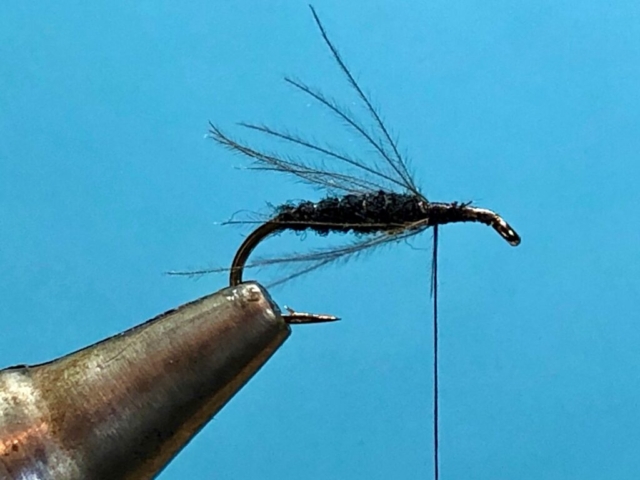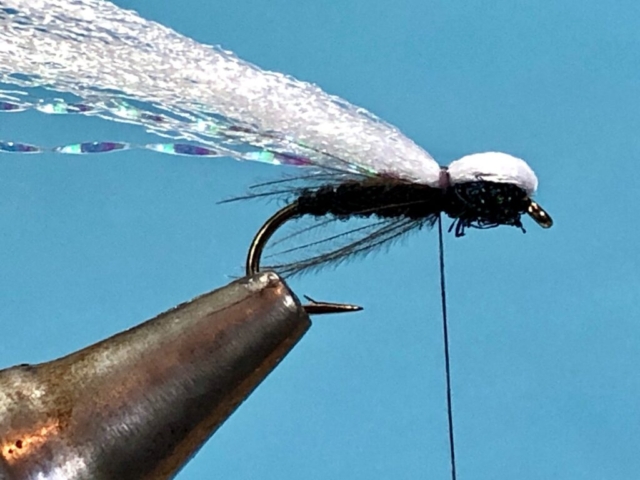
A Fly to Tie and Try May 2021
Fly of the Month – May
The Summer Bibio (Dry)
Hook: Kamasan B170, medium wire hook, size 14.
Thread: Black Semperfli Nanosilk, 30 Denier, or any fine black thread.
Rib: Black tying thread.
Abdomen: Black Superfine dubbing, or similar fine dry fly dubbing.
Legs: Natural CDC feather, wound as a hackle.
Under Wing (Optional): 2 Strands of pearl Krinkle Mirror Flash.
Over Wing: 2 Strands of white Aero Dry Wing.
Thorax: Black Ice Dub, or similar.
Photo 1. Place the hook in the vice and catch on the thread behind the eye leaving a long thread tag. Now wind the thread in touching turns to opposite the barb. Do not cut off the thread tag as this will be used for the rib
Photo 2. Lightly dub a thin noodle of Superfine dubbing onto the thread then wind it up the shank to form a slim tapered abdomen, stopping at the thorax. Now, use the thread tag to rib the abdomen in open spirals and tie it in at the thorax and remove the excess tag.
Photo 3. Tie in a small CDC feather by its tip using well waxed thread and then remove any excess tip. Now wind on one turn of the feather and secure it with thread before removing the excess feather.
Photo 4. Tie in 2 strands of Mirror Flash extending rearwards over the back of the fly.
Photo 5. Tie in 2 strands of Aero Dry Wing forward over the eye, ensuring the thread finishes immediately behind the eye.
Photo 6. Dub a small pinch of Ice Dub onto the thread and wind it rearwards forming a small ball shaped thorax, leaving the thread immediately in front of the CDC fibres.
Photo 7. Pull the Aero wing material back over the top of the thorax and tie it down with just one turn of well waxed thread. Add a drop of varnish or superglue to the thread and whip finish though it with only 2 turns of thread and cut off the thread.
Photo 8. Trim both the Mirror Flash and Aero Dry Wing to the hook length to complete the fly.
Tying tips
- Fine threads such as Sheer 14/0 or Veevus 16/0 help to avoid an unsightly buildup of thread when finishing off behind the thorax. My preference is for 30 denier Semperfli Nanosilk, which is a very fine and unbelievably strong GSP (gel spun polyethylene) type of thread, but it does require regular waxing to stop it slipping.
- To help create an even thread base, hold the tag end of thread tight and at an angle of about 60 degrees to the hook shank, then wind the thread onto the tag just before the shank. In this way, the tag acts both as a stop, to prevent the thread from moving too far forward and as a guide, ensuring each thread turn naturally butts up against the previous turn.
- If the CDC legs are too long, a more natural result is produced by pinching off the excess with finger and thumb rather than cutting with scissors.
- I tie this fly both with and without the flash underwing, as sometimes the fish seem to prefer one over the other.
- To ensure the fly floats, brush it with liquid Mucilin Dry Fly Silicone and leave to dry thoroughly for 24 hours before transferring to your fly box.
Fishing notes
- I devised the Summer Bibio four years ago as an attempt to better represent the black gnat, Bibio johannis. This small black terrestrial fly with brownish legs and shiny wings, is present in large numbers from May through to September and the trout love them.
- In spring, the flies are attracted to the yellow gorse bushes around the loch, so it pays to keep an eye on wind direction and if possible, target areas downwind of the gorse bushes.
- I usually fish the Summer Bibio as a single fly on a floating line and tapered leader, but since the fly sits right in the surface film, spotting takes can be tricky. I simply lift into any rise near the end of my fly line and surprisingly often, a positive hook up results. So much so, that over the last 2 seasons this pattern has been my most productive dry fly at Coldingham.
- On windier days during May, the largest British bibionid, the Hawthorn fly, Bibio marci, is also likely to put in an appearance, so a two fly cast consisting of a dry hawthorn on the point and Summer Bibio on the dropper, is a very effective combination. Rises to the hawthorn are usually obvious affairs, but often the first indication of a take to the Summer Bibio, which is likely to be fishing just sub surface, is that the fly line simply pulls away, in similar fashion to a buzzer take.
- Last year (2019), I was delighted and amazed in equal measure, to discover that the Summer Bibio continued to produce excellent returns for other anglers right up until the very last day of the season. This says much about the effectiveness of the fly, but it also underlines Coldingham Loch’s richly deserved reputation as one of the country’s very best top of the water fisheries.
** Please note Les wrote this In Jan 2020 for the 2020 season which was not published as we were closed due to lockdown and so any references made to the year are referring to 2020.











Recent Comments